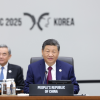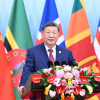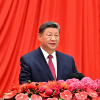热词翻译:“取消农业税”英文怎么说?
“取消农业税”英文怎么说?
根据热词译文件报告翻译数据库,在《中共中央关于党的百年奋斗重大成就和历史经验的决议》的翻译中,“取消农业税”被翻译为:
取消农业税
rescind taxes on agriculture
rescind taxes on agriculture
例句如下:
党加快推进以改善民生为重点的社会建设,改善人民生活,取消农业税,不断推进学有所教、劳有所得、病有所医、老有所养、住有所居,促进社会和谐稳定。
The Party accelerated social development with a focus on improving public wellbeing. It worked to improve people’s living standards and rescinded taxes on agriculture. It devoted constant effort to ensuring access to education, employment, medical services, elderly care, and housing and to promoting social harmony and stability.
The Party accelerated social development with a focus on improving public wellbeing. It worked to improve people’s living standards and rescinded taxes on agriculture. It devoted constant effort to ensuring access to education, employment, medical services, elderly care, and housing and to promoting social harmony and stability.
热词链接
“取消农业税”在其他来源中的翻译:
1 《《人类减贫的中国实践》白皮书》中“取消农业税”的翻译
进入21世纪,以胡锦涛同志为总书记的中共中央,坚持科学发展观,构建社会主义和谐社会,提出全面建成小康社会目标,推进社会主义新农村建设,制定实施一系列扶贫开发新政策新举措。对扶贫工作重点与瞄准对象作出重大调整,把中西部地区作为扶贫工作重点区域,在592个国家扶贫工作重点县的基础上,选定15万个贫困村作为扶贫对象,实施参与式“整村推进”扶贫。大力推进产业扶贫和劳动力培训转移,积极开展易地搬迁扶贫和生态移民。实施西部大开发、振兴东北地区等老工业基地、中部地区崛起等国家区域发展战略,促进区域、城乡协调发展。取消农业税,建立新型农村合作医疗等一系列农村社会保障制度,农民负担重的状况得到根本性改变。2011年,中共中央召开扶贫开发工作会议,中共中央、国务院印发《中国农村扶贫开发纲要(2011-2020年)》。中国的扶贫开发,从以解决温饱为主要任务的阶段转入巩固温饱成果、加快脱贫致富、改善生态环境、提高发展能力、缩小发展差距的新阶段。按照当时的扶贫标准,2010年底,中国农村贫困人口减少到2688万人,贫困发生率降为2.8%;2011年,中国将扶贫标准提高到2300元,在新的扶贫标准下,中国贫困人口为1.22亿。
In the 21st century, the CPC Central Committee with Comrade Hu Jintao as General Secretary embraced the Scientific Outlook on Development. Its goals were to advance the development of a harmonious society, build a moderately prosperous society in all respects, and facilitate the development of a new socialist countryside. It enacted a new series of poverty alleviation policies and measures. This resulted in major adjustments to the focus and targets of poverty alleviation work, listing the central and western regions as the priority region, and choosing as individual targets 150,000 impoverished villages besides the 592 key counties, where the full participation of villagers in poverty alleviation efforts was encouraged. A whole range of efforts were directed to business development, the training and transfer of rural labor, poverty alleviation through relocation, and relocation for the development of the eco-economy. State strategy of regional development was implemented, such as developing west China, revitalizing old industrial bases in the northeast, and stimulating the rise of the central region. These achieved coordinated development between regions and between rural and urban areas. The Agricultural Tax was abolished and a series of rural social security systems such as the new cooperative medical care system were established, greatly easing the burden on farmers. The National Conference on Development-driven Poverty Alleviation in 2011 made plans for a new phase in the battle against poverty to ensure that moderate prosperity in all respects would be achieved by 2020. After the meeting, the CPC Central Committee and the State Council issued the Outline of Development-driven Poverty Alleviation in Rural Areas (2011-2020). China's poverty alleviation effort had evolved from its primary mission – meeting the basic needs of the poor – to a new stage of consolidating this achievement, accelerating poverty alleviation, improving the eco-environment, increasing development capacity, and bridging the development gap. By the end of 2010, according to the poverty standard, the impoverished rural population had been reduced to 26.88 million, and the incidence of poverty had fallen to 2.8%. In 2011, the standard was raised to RMB2,300, and accordingly the poor population was 122 million.
In the 21st century, the CPC Central Committee with Comrade Hu Jintao as General Secretary embraced the Scientific Outlook on Development. Its goals were to advance the development of a harmonious society, build a moderately prosperous society in all respects, and facilitate the development of a new socialist countryside. It enacted a new series of poverty alleviation policies and measures. This resulted in major adjustments to the focus and targets of poverty alleviation work, listing the central and western regions as the priority region, and choosing as individual targets 150,000 impoverished villages besides the 592 key counties, where the full participation of villagers in poverty alleviation efforts was encouraged. A whole range of efforts were directed to business development, the training and transfer of rural labor, poverty alleviation through relocation, and relocation for the development of the eco-economy. State strategy of regional development was implemented, such as developing west China, revitalizing old industrial bases in the northeast, and stimulating the rise of the central region. These achieved coordinated development between regions and between rural and urban areas. The Agricultural Tax was abolished and a series of rural social security systems such as the new cooperative medical care system were established, greatly easing the burden on farmers. The National Conference on Development-driven Poverty Alleviation in 2011 made plans for a new phase in the battle against poverty to ensure that moderate prosperity in all respects would be achieved by 2020. After the meeting, the CPC Central Committee and the State Council issued the Outline of Development-driven Poverty Alleviation in Rural Areas (2011-2020). China's poverty alleviation effort had evolved from its primary mission – meeting the basic needs of the poor – to a new stage of consolidating this achievement, accelerating poverty alleviation, improving the eco-environment, increasing development capacity, and bridging the development gap. By the end of 2010, according to the poverty standard, the impoverished rural population had been reduced to 26.88 million, and the incidence of poverty had fallen to 2.8%. In 2011, the standard was raised to RMB2,300, and accordingly the poor population was 122 million.

 习近平在亚太经合组织第三十二次领导人非正式会议第一阶段会议上的讲话
习近平在亚太经合组织第三十二次领导人非正式会议第一阶段会议上的讲话 习近平在全球妇女峰会开幕式的主旨讲话
习近平在全球妇女峰会开幕式的主旨讲话 习近平在庆祝中华人民共和国成立76周年招待会上的讲话
习近平在庆祝中华人民共和国成立76周年招待会上的讲话 习近平在金砖国家领导人线上峰会的讲话
习近平在金砖国家领导人线上峰会的讲话 习近平:在纪念中国人民抗日战争暨世界反法西斯战争胜利80周年招待会上的讲话
习近平:在纪念中国人民抗日战争暨世界反法西斯战争胜利80周年招待会上的讲话